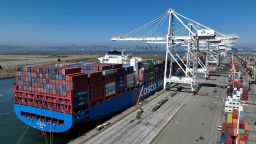Editor’s Note: Sign up for CNN’s Meanwhile in China newsletter which explores what you need to know about the country’s rise and how it impacts the world.
China’s key real estate sector hasn’t shown much improvement following a flurry of government measures taken to boost the industry, even as other parts of the economy seem to be stabilizing.
New property sales reached a total of 1.06 trillion yuan ($147 billion) in the first two months of this year, according to data released by the National Bureau of Statistics (NBS) on Monday. That’s equivalent to a fall of 29.3% compared to the same period in 2023.
The drop also marks a much faster pace of decline from the year-ago period, when new property sales dipped just 0.1%.
Property investment fell 9% in the January-to-February period, which was faster than the 5.7% decrease registered during the same period last year.
“The correction in property construction is still in its early stages,” Capital Economics analysts said in a research note on Monday. “We expect it [property construction] to halve in the coming years, pulling down economic growth over the medium-term.”
However, other parts of the economy — including consumption, industrial production and infrastructure investment — appear to show improvement thanks to a holiday spending boom, strong exports and state-led infrastructure push.
Retail sales increased 5.5% in January-February from the same period a year earlier, which was slightly higher than an expected 5.2% increase from a Reuters poll of analysts.
Catering services, telecoms, cigarettes and tobacco, and sports and entertainment services registered the highest growth in sales.
But it is still uncertain if the improvement will continue. “Consumers were buoyed temporarily by festivities-related spending at this start of the year,” said Louise Loo, China economist at Oxford Economics.
Industrial output jumped 7% during the first two months of this year from the same period in 2023, beating the 5% growth forecast in the Reuters poll.
That’s in line with the strong Caixin manufacturing Purchasing Managers Index released by S&P Global earlier this month. The index, which focuses on export-oriented manufacturing firms in mainland China, rose to 50.9 in February, up from 50.8 in January, marking a fourth straight month of expansion.
The growth in factory output might be driven by strong exports demand. Separate customs figures showed that China’s exports jumped 7.1% in the January-to-February period from a year ago, well above market expectations.
Investment in fixed assets — such as factories, roads, and power grids — increased 4.2% in the first two months of this year, surpassing analyst estimates.
This is mainly driven by state-led investment, the NBS data showed.
Still, the property downturn and weak domestic demand call for more policy support to sustain growth.
“In the absence of decisive consumption-related stimulus this year, we think it would be difficult to sustain a robust consumer spending pace,” Loo said.
Some of the government’s new initiatives to spur consumer spending — including the replacement of old durable goods, such as cars and home appliances, with new ones— would be “hugely beneficial,” she added.
“Economic outlook in [the second quarter] is still quite uncertain,” said Zhiwei Zhang, president and chief economist at Pinpoint Asset Management.
“While exports helped to partially offset the weak domestic momentum [at the start of the year], a sustainable recovery requires more policy support, particularly from the fiscal side,” he said.









